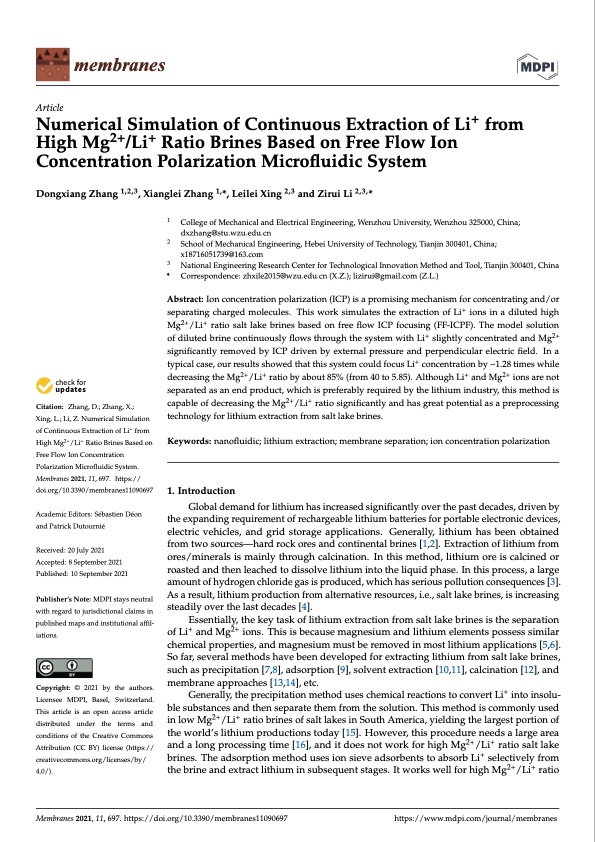
PDF Publication Title:
Text from PDF Page: 001
membranes Article Numerical Simulation of Continuous Extraction of Li+ from High Mg2+/Li+ Ratio Brines Based on Free Flow Ion Concentration Polarization Microfluidic System Dongxiang Zhang 1,2,3, Xianglei Zhang 1,*, Leilei Xing 2,3 and Zirui Li 2,3,* Citation: Zhang,D.;Zhang,X.; Xing, L.; Li, Z. Numerical Simulation of Continuous Extraction of Li+ from High Mg2+ /Li+ Ratio Brines Based on Free Flow Ion Concentration Polarization Microfluidic System. Membranes2021,11,697. https:// doi.org/10.3390/membranes11090697 Academic Editors: Sébastien Déon and Patrick Dutournié Received: 20 July 2021 Accepted: 8 September 2021 Published: 10 September 2021 Publisher’s Note: MDPI stays neutral with regard to jurisdictional claims in published maps and institutional affil- iations. Copyright: © 2021 by the authors. Licensee MDPI, Basel, Switzerland. This article is an open access article distributed under the terms and conditions of the Creative Commons Attribution (CC BY) license (https:// creativecommons.org/licenses/by/ 4.0/). 1 2 3 Abstract: Ion concentration polarization (ICP) is a promising mechanism for concentrating and/or separating charged molecules. This work simulates the extraction of Li+ ions in a diluted high Mg2+/Li+ ratio salt lake brines based on free flow ICP focusing (FF-ICPF). The model solution of diluted brine continuously flows through the system with Li+ slightly concentrated and Mg2+ significantly removed by ICP driven by external pressure and perpendicular electric field. In a typical case, our results showed that this system could focus Li+ concentration by ~1.28 times while decreasing the Mg2+/Li+ ratio by about 85% (from 40 to 5.85). Although Li+ and Mg2+ ions are not separated as an end product, which is preferably required by the lithium industry, this method is capable of decreasing the Mg2+/Li+ ratio significantly and has great potential as a preprocessing technology for lithium extraction from salt lake brines. Keywords: nanofluidic; lithium extraction; membrane separation; ion concentration polarization 1. Introduction Global demand for lithium has increased significantly over the past decades, driven by the expanding requirement of rechargeable lithium batteries for portable electronic devices, electric vehicles, and grid storage applications. Generally, lithium has been obtained from two sources—hard rock ores and continental brines [1,2]. Extraction of lithium from ores/minerals is mainly through calcination. In this method, lithium ore is calcined or roasted and then leached to dissolve lithium into the liquid phase. In this process, a large amount of hydrogen chloride gas is produced, which has serious pollution consequences [3]. As a result, lithium production from alternative resources, i.e., salt lake brines, is increasing steadily over the last decades [4]. Essentially, the key task of lithium extraction from salt lake brines is the separation of Li+ and Mg2+ ions. This is because magnesium and lithium elements possess similar chemical properties, and magnesium must be removed in most lithium applications [5,6]. So far, several methods have been developed for extracting lithium from salt lake brines, such as precipitation [7,8], adsorption [9], solvent extraction [10,11], calcination [12], and membrane approaches [13,14], etc. Generally, the precipitation method uses chemical reactions to convert Li+ into insolu- ble substances and then separate them from the solution. This method is commonly used in low Mg2+/Li+ ratio brines of salt lakes in South America, yielding the largest portion of the world’s lithium productions today [15]. However, this procedure needs a large area and a long processing time [16], and it does not work for high Mg2+/Li+ ratio salt lake brines. The adsorption method uses ion sieve adsorbents to absorb Li+ selectively from the brine and extract lithium in subsequent stages. It works well for high Mg2+/Li+ ratio College of Mechanical and Electrical Engineering, Wenzhou University, Wenzhou 325000, China; dxzhang@stu.wzu.edu.cn School of Mechanical Engineering, Hebei University of Technology, Tianjin 300401, China; x18716051739@163.com National Engineering Research Center for Technological Innovation Method and Tool, Tianjin 300401, China * Correspondence: zhxile2015@wzu.edu.cn (X.Z.); lizirui@gmail.com (Z.L.) Membranes 2021, 11, 697. https://doi.org/10.3390/membranes11090697 https://www.mdpi.com/journal/membranesPDF Image | Brines Based on Free Flow Ion Concentration Polarization

PDF Search Title:
Brines Based on Free Flow Ion Concentration PolarizationOriginal File Name Searched:
membranes-11-00697-v2.pdfDIY PDF Search: Google It | Yahoo | Bing
Product and Development Focus for Infinity Turbine
ORC Waste Heat Turbine and ORC System Build Plans: All turbine plans are $10,000 each. This allows you to build a system and then consider licensing for production after you have completed and tested a unit.Redox Flow Battery Technology: With the advent of the new USA tax credits for producing and selling batteries ($35/kW) we are focussing on a simple flow battery using shipping containers as the modular electrolyte storage units with tax credits up to $140,000 per system. Our main focus is on the salt battery. This battery can be used for both thermal and electrical storage applications. We call it the Cogeneration Battery or Cogen Battery. One project is converting salt (brine) based water conditioners to simultaneously produce power. In addition, there are many opportunities to extract Lithium from brine (salt lakes, groundwater, and producer water).Salt water or brine are huge sources for lithium. Most of the worlds lithium is acquired from a brine source. It's even in seawater in a low concentration. Brine is also a byproduct of huge powerplants, which can now use that as an electrolyte and a huge flow battery (which allows storage at the source).We welcome any business and equipment inquiries, as well as licensing our turbines for manufacturing.| CONTACT TEL: 608-238-6001 Email: greg@infinityturbine.com | RSS | AMP |